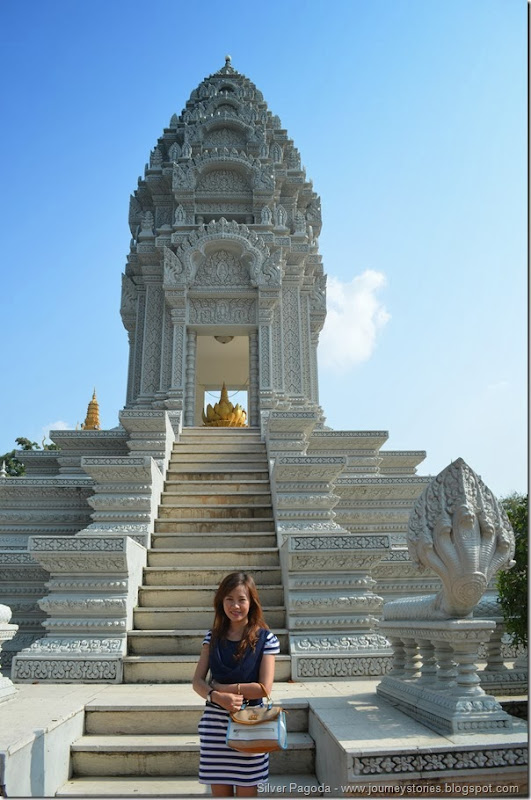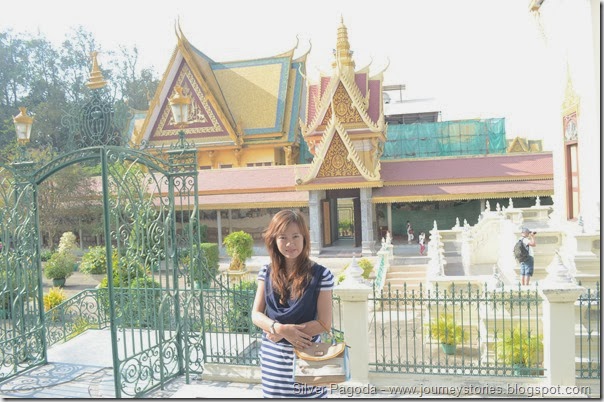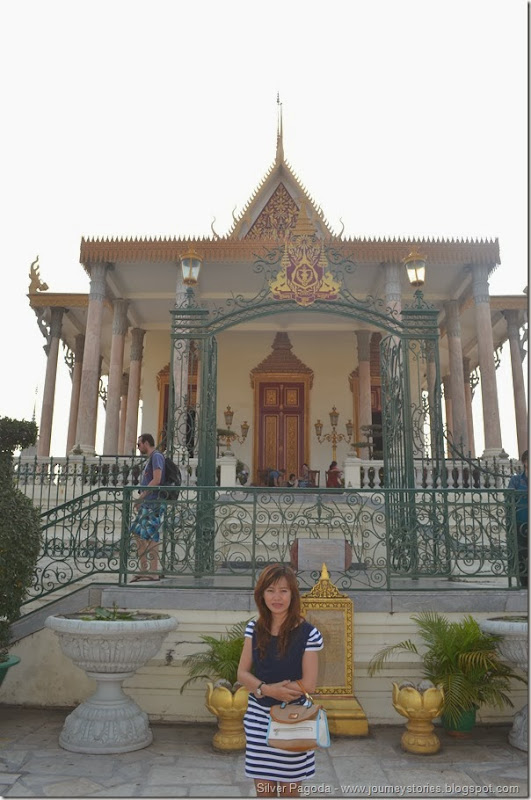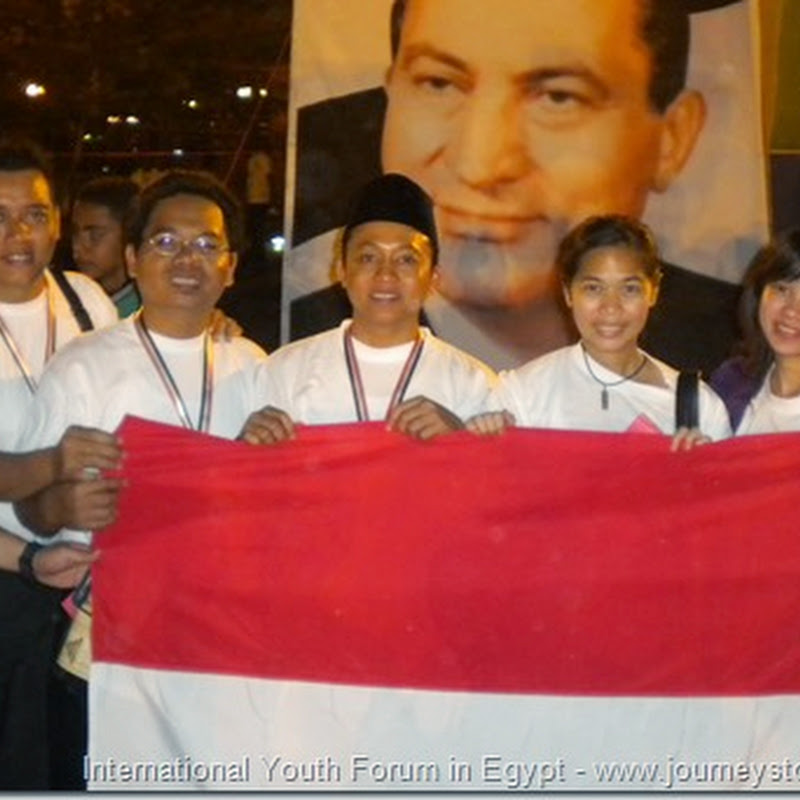It has been quite a long time I have been absent from writing my blog. Since my pregnancy last July, I started to lose my mood to do almost anything even writing. But in this seventh-month pregnancy, I decide to continue updating my blog. Still talking about Cambodia, continuing our tuk-tuk trip from the Independence Monument, we visited one of the most prominent landmarks in the city, the Royal Palace and Silver Pagoda. In normal days, only some parts of the complex are open to public because the King of Cambodia still lives in the Royal Palace. Unfortunately, at that time access to the Royal Palace was temporarily closed for public due to the decease of King Sihanouk. Everyone was mourning over him and surely there were lots of ceremonies held inside. Hence, we just entered the Silver Pagoda. The ticket price was around US$ 3 per person and if you bring camera, there is an additional cost of US$ 2 for camera and US$ 5 for video. They only charge tourists but give free admissions to the local Cambodians. The pagoda is open daily from 8 a.m. to 11 a.m. and 2:30 p.m. to 5 p.m. Although visitors can bring their cameras inside the compound, photography is only permitted in the outer side of the exhibition areas only. Visitors are not allowed to take photo inside the pagoda. Therefore, what I can show you here is only pictures of the exterior of the structure and I cannot provide you with detailed photographs of what is inside the pagoda.
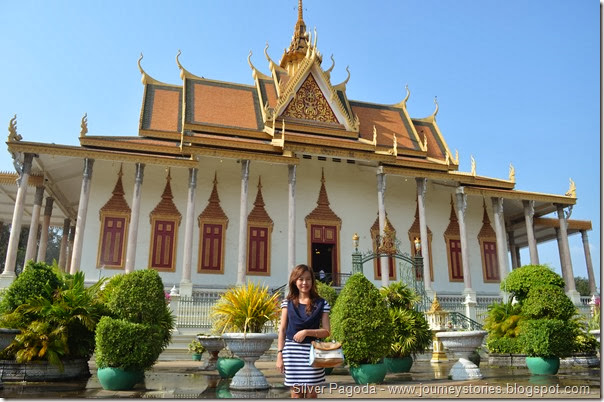
Situated within the same complex, Silver Pagoda and Royal Palace are two neighboring structures that proudly boast the Khmer-origin architecture. Overlooking the riverfront park, the pagoda is only separated by a walled walkway from the Royal Palace. The official name of the pagoda is actually “Preah Vihear Preah Keo Morakot” but the locals refer to it as Wat Preah Keo Morokat, which means “The Temple of Emerald Buddha”, for it houses the famous Buddha statue made of priceless emerald which the Cambodians call Keo Morakot. Despite of this, foreigners prefer to call it Silver Pagoda because of the approximately 5,000 genuine gleaming silver tiles weighing 5 tons that adorn the floor of the pagoda. Inspired by Bangkok’s Wat Phra Keo, the pagoda was first constructed by King Norodom between 1892 and 1902. King Norodom Sihanouk ever lived there for one year when he joined monkhood on July 31, 1947. The first structure was built using wood and brick materials. However, this vulnerable building was destroyed by fire and then rebuilt in 1962 by his predecessor, King Sihanouk, who used more concrete materials like iron and silver. Before retaining its current name, the pagoda used to be called Wat Uborsoth Rotannaram because it was used by the King as a place to worship, pray and practice every Buddhist Silas Day. Silver Pagoda is the official royal temple where the King of Cambodia meets the monks to listen to their sermons and where some royal ceremonies take place. However, no monk lives here.
Located to the south of the Royal Palace, the pagoda compound comprises of the main building, garden and other structures like library, various stupas, shrines, monuments, the galleries of the Reamker and other minor buildings.
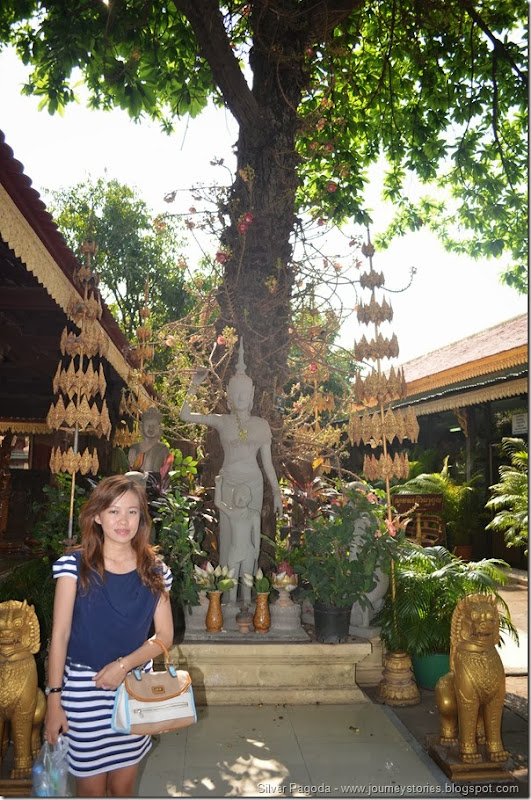 Since the access to the Royal Palace was closed for public, we entered through a small gate of the pagoda. The first statue I met was this one. This tree is called the Buddha Tree.
Since the access to the Royal Palace was closed for public, we entered through a small gate of the pagoda. The first statue I met was this one. This tree is called the Buddha Tree.
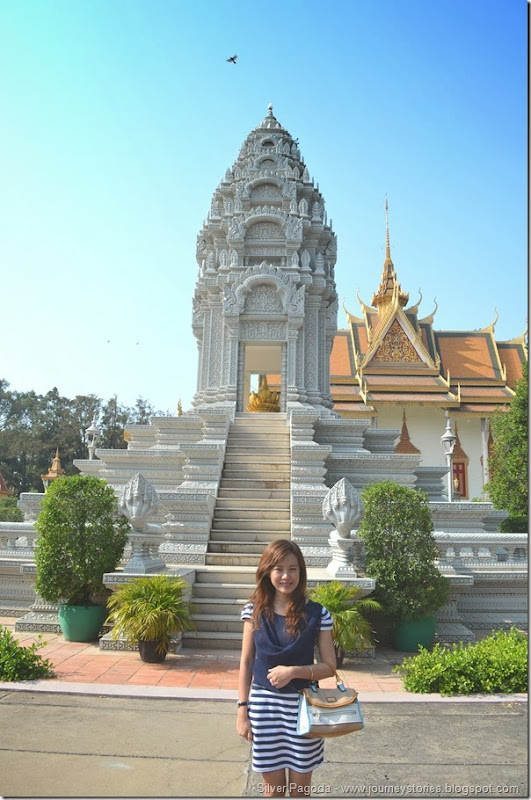 There are actually five stupas or chedis with intricate designs at the ground of the complex that keep the ashes of kings, queens and other royal family members.
There are actually five stupas or chedis with intricate designs at the ground of the complex that keep the ashes of kings, queens and other royal family members.
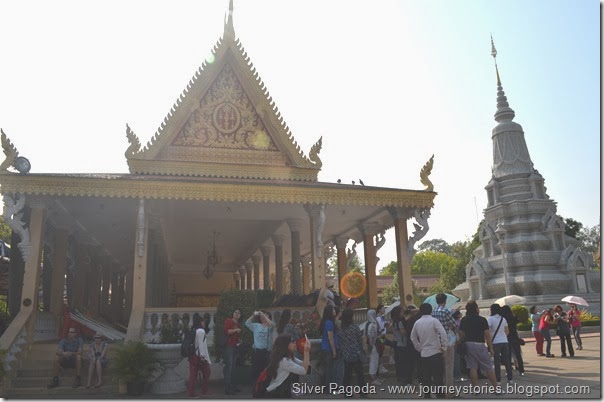 There were many foreigners visited the pagoda. Although I had some Cambodian friends with me, they could not explain to me about the features inside the complex. Sigh… As a result, I did not know a lot about the place.
There were many foreigners visited the pagoda. Although I had some Cambodian friends with me, they could not explain to me about the features inside the complex. Sigh… As a result, I did not know a lot about the place.
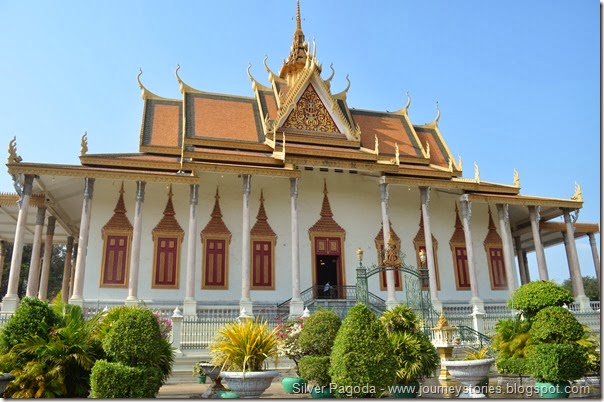
This is the prominent structure of the whole pagoda complex. It is what the locals call Wat Preah Keo Morokat or Silver Pagoda. Unfortunately, no photograph is allowed inside the building so I can only show you the exterior. Before entering the temple, visitors must take off their shoes and no camera is allowed. Be sure to behave properly and not make any noise inside the temple. What I see inside was three Buddha statues with the largest in the middle known as the Emerald Buddha statue. Even though the pagoda is most famous for its 5,329 handcrafted silver tiles, each around 20cm square and weighing 1.124 kg, most of the tiles are covered with red carpet for the sake of protection. There is only a small portion of the tiles visible to the visitors today, so you can only see small part of it that is delicately engraved with leaf motifs. However, those small sections of tiles were not polished so they looked dull and uninteresting. If at that time there had not been a guide explaining to other visitor about the silver tiles, I would not have noticed that the floor I was stepping on was made of real silver. Oh my gosh…
The inner side of the temple also exhibits 1,650 national treasures of Cambodia made from gold, silver, bronze and other valuable materials, which most of them are in the form of Buddha statues. Those are gifts from the King, the royal family, dignitaries and other people who worship there. During the Khmer Rouge regime, 60% of the objects inside the pagoda were destroyed and only a few remnants were preserved as a propaganda tool to demonstrate to the outside world that the regime also cared for the conservation of Cambodian heritage.

The pagoda compound walls are decorated with murals telling the stories from the Reamker, which is the Khmer version of Indian epic like Ramayana. Originally painted in 1903 – 1904 by a team of students under the direction of artist Vichitre Chea and architect Oknha Tep Nimit Thneak, the murals are in poor condition due to lack of maintenance and weather damage. To understand the full story, you should start at east gate and continue all along until the end of these 642-meter walls. However, when I was there, I did not really take notice of the painted walls so I did not take any picture of it.
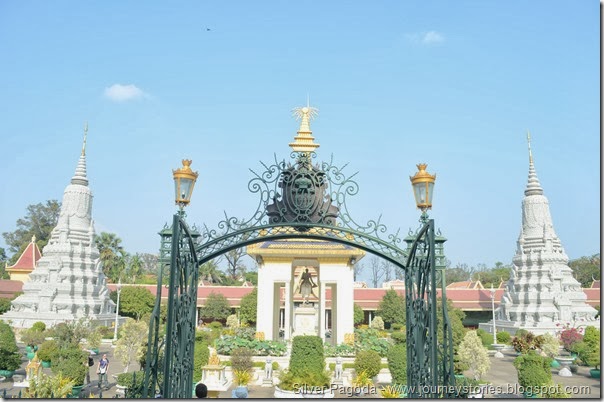 In front of the main temple and between the two main stupas stands the equestrian statue of King Norodom sitting on a horse in full Napoleon III full attire. Unfortunately, at that time I did not realize the importance and meaning of the statue so I just took the back picture of it. The statue was a keepsake from the French King Napoleon III to King Norodom which was completed by French artist Eude in 1875 in Paris and set in its current place in 1892. Originally, the head of the statue resembled Napoleon himself, but it was changed to become like King Norodom. When first erected, the statue had no roof but after King Sihanouk successfully won independence from France on Nov 11, 1953, a roof was added to cover it to honor King Norodom.
In front of the main temple and between the two main stupas stands the equestrian statue of King Norodom sitting on a horse in full Napoleon III full attire. Unfortunately, at that time I did not realize the importance and meaning of the statue so I just took the back picture of it. The statue was a keepsake from the French King Napoleon III to King Norodom which was completed by French artist Eude in 1875 in Paris and set in its current place in 1892. Originally, the head of the statue resembled Napoleon himself, but it was changed to become like King Norodom. When first erected, the statue had no roof but after King Sihanouk successfully won independence from France on Nov 11, 1953, a roof was added to cover it to honor King Norodom.
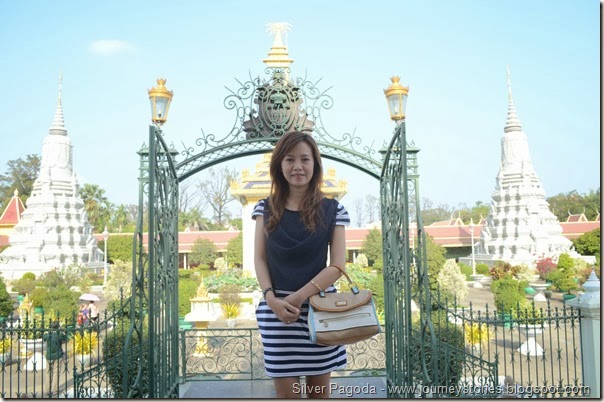 To the east of the complex and separated by the equestrian statue of King Norodom stands the two largest stupas that contain the ashes of the most famous kings of modern Cambodia, King Norodom and King Udung.
To the east of the complex and separated by the equestrian statue of King Norodom stands the two largest stupas that contain the ashes of the most famous kings of modern Cambodia, King Norodom and King Udung.
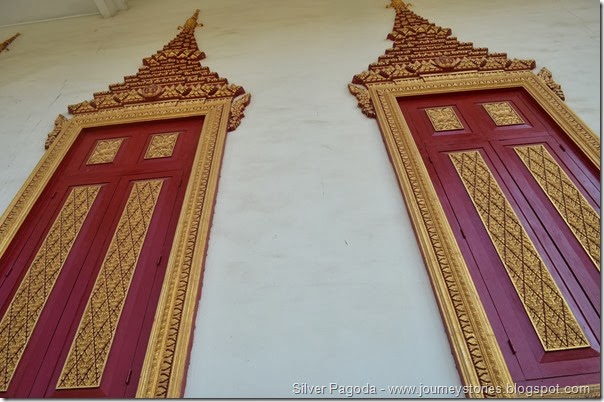 The windows of the temple are really unique in design and architecture, real taste of Cambodians.
The windows of the temple are really unique in design and architecture, real taste of Cambodians.
Cambodia is predominantly a Buddhist country where a lot of pagodas, temples and shrines are found almost in every corner of the city. To the untrained eyes of a foreigner like me, almost all structures look the same. However, Silver Pagoda is the most extravagant and architecturally unique one. So, if you want to make your trip to Cambodia a real different, visiting the pagoda is something you must not miss.
Sources:
Personal experience and additional information from other online articles
 Since the access to the Royal Palace was closed for public, we entered through a small gate of the pagoda. The first statue I met was this one. This tree is called the Buddha Tree.
Since the access to the Royal Palace was closed for public, we entered through a small gate of the pagoda. The first statue I met was this one. This tree is called the Buddha Tree.  There are actually five stupas or chedis with intricate designs at the ground of the complex that keep the ashes of kings, queens and other royal family members.
There are actually five stupas or chedis with intricate designs at the ground of the complex that keep the ashes of kings, queens and other royal family members.  There were many foreigners visited the pagoda. Although I had some Cambodian friends with me, they could not explain to me about the features inside the complex. Sigh… As a result, I did not know a lot about the place.
There were many foreigners visited the pagoda. Although I had some Cambodian friends with me, they could not explain to me about the features inside the complex. Sigh… As a result, I did not know a lot about the place.  In front of the main temple and between the two main stupas stands the equestrian statue of King Norodom sitting on a horse in full Napoleon III full attire. Unfortunately, at that time I did not realize the importance and meaning of the statue so I just took the back picture of it. The statue was a keepsake from the French King Napoleon III to King Norodom which was completed by French artist Eude in 1875 in Paris and set in its current place in 1892. Originally, the head of the statue resembled Napoleon himself, but it was changed to become like King Norodom. When first erected, the statue had no roof but after King Sihanouk successfully won independence from France on Nov 11, 1953, a roof was added to cover it to honor King Norodom.
In front of the main temple and between the two main stupas stands the equestrian statue of King Norodom sitting on a horse in full Napoleon III full attire. Unfortunately, at that time I did not realize the importance and meaning of the statue so I just took the back picture of it. The statue was a keepsake from the French King Napoleon III to King Norodom which was completed by French artist Eude in 1875 in Paris and set in its current place in 1892. Originally, the head of the statue resembled Napoleon himself, but it was changed to become like King Norodom. When first erected, the statue had no roof but after King Sihanouk successfully won independence from France on Nov 11, 1953, a roof was added to cover it to honor King Norodom.  To the east of the complex and separated by the equestrian statue of King Norodom stands the two largest stupas that contain the ashes of the most famous kings of modern Cambodia, King Norodom and King Udung.
To the east of the complex and separated by the equestrian statue of King Norodom stands the two largest stupas that contain the ashes of the most famous kings of modern Cambodia, King Norodom and King Udung.





